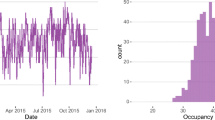Abstract
This paper describes an application of the approximated hypercube model to Lisbon emergency medical services (EMS) management, namely for assessing alternative dispatching rules for assigning ambulances to emergency calls. The approximated hypercube (A-hypercube) is a queuing theory model that computes several performance measures such as average response time, server workloads or the probability of all servers being busy (loss probability). The assumptions of the extended model are Poisson customer arrivals, general service time (customer and server dependent) and a fixed preference assignment rule of servers to customers. The fact that dispatching rules are precisely a model parameter, turn this model into a valuable tool in the definition of efficient operating rules. In this paper, we propose new expressions for the computation of system performance measures during periods in which the emergency call arrival process is not stationary. Different dispatching rules are evaluated by comparing the system performance measures obtained from the extended A-hypercube model and a simulation model, using data collected from the Lisbon EMS Department.
Similar content being viewed by others
References
Baker J, Clayton E, Taylor B (1989) A non-linear multi-criteria programming approach for determining county emergency medical service ambulance allocations. J Oper Res Soc 5: 423–432
Baptista S (2007) Avaliação de regras de afectação em tempo real de veículos de emergência médica. Dissertation, Instituto Superior Técnico, Universidade Técnica de Lisboa
Benveniste R (1985) Solving the combined zoning and location problem for several emergency units. J Oper Res Soc 36: 433–450
Brotcorne L, Laporte G, Semet F (2003) Ambulance location and relocation models. Eur J Oper Res 147: 451–463
Budge S, Ingolfsson A, Erkut E (2008) Optimal ambulance location with random delays and travel times. Health Care Manag Sci 11: 262–274
Budge S, Ingolfsson A, Erkut E (2009) Approximating vehicle dispatch probabilities for emergency service systems with location-specific service times and multiple units per location. Oper Res 57: 251–255
Burwell T, Jarvis J, Mcknew M (1993) Modeling co-located servers and dipatch ties in the hypercube model. Comput Oper Res 20: 113–119
Carter G, Chaiken J, Ignall E (1972) Response areas for two emergency units. Oper Res 20: 571–594
Chaterjee, Hadi (2006) Regression analysis by example, 4th edn. Wiley, New York
Cuninghame-Green R, Harries G (1988) Nearest-neighbour rules for emergency services. Zeitschrift für Operations Research 32: 299–306
Fleischer R, Wahl M (2000) On-line scheduling revisited. J Schedul 3: 343–353
Gendreau M, Laporte G, Semet F (1997) Solving an ambulance location model by tabu search. Location Sci 5: 75–88
Galvão R, Chiyoshi F, Morabito R (2005) Towards unified formulations and extensions of two classical probabilistic location models. Comput Oper Res 32: 15–33
Goldberg J (2004) Operations research models for the deployment of emergency service vehicles. EMS Manag J 1: 20–39
Goldberg J, Dietrich R, Chen J, Mitwasi G, Valenzuela T, Criss E (1990) Validating and applying a model for locating emergency medical vehicles in Tucson, Az. Eur J Oper Res 49: 308–324
Goldberg J, Paz L (1991) Locating emergency vehicle bases when service time depends on call location. Transport Sci 25: 264–280
Goldberg J, Szidarovsky F (1991) Methods for solving nonlinear equations used in evaluating emergency vehicle busy probabilities. Oper Res 39: 903–916
Iannnoni A, Morabito R, Saydam C (2008) A hypercube queueing model embedded into a genetic algorithm for ambulance deployment on highways. Ann Oper Res 157: 207–224
Iannnoni A, Morabito R, Saydam C (2009) An optimization approach for ambulance location and the districting of the response segments on highways. Eur J Oper Res 195: 528–542
Jarvis J (1985) Approximating the equilibrium behavior of multi-server loss systems. Manag Sci 31: 235–239
Larson R (1974) A hypercube queuing model for facility location and redistricting in urban emergency services. Comput Oper Res 1: 67–95
Larson R (1975) Approximating the performance of urban emergency service systems. Oper Res 23: 845–868
Larson H (1982) Introduction to probability theory and statistical inference, 3rd edn. Wiley, New York
Law A, Kelton W (2000) Simulation modeling and analysis. 3rd edn. McGraw Hill,
Mclay L (2009) A maximum expected covering location model with two type of servers. IIE Trans 41: 730–741
Mendonça F, Morabito R (2001) Analysing emergency medical service ambulance deployment on a Brazilian highway using the hypercube model. J Oper Res Soc 52: 261–270
Parzen E (1962) Stochastic processes. SIAM, Philadelphia
Rajagopalan HK, Saydam C, Xiao J (2008) A multiperiod set covering location model for dynamic redeployment of ambulances. Comput Oper Res 35: 814–826
Repede J, Bernardo J (1994) Developing and validating a decision support system for locating emergency medical vehicles in Louisville, Kentucky. Eur J Oper Res 75: 567–581
Saydam C, Aytug H (2003) Accurate estimation of expected coverage: revisited. Soc Econ Plan Sci 37: 69–80
Singer M, Donoso P (2008) Assessing an ambulance service with queuing theory. Comput Oper Res 35: 2548–2560
Takeda R, Widmer J, Morabito R (2007) Analysis of ambulance decentralization in an urban emergency medical service using the hypercube queuing model. Comput Oper Res 34: 727–741
Venkateshan P, Mathur K, Ballou R (2010) Locating and staffing service centers under service level constraints. Eur J Oper Res 201: 55–70
Author information
Authors and Affiliations
Corresponding author
Rights and permissions
About this article
Cite this article
Baptista, S., Oliveira, R.C. A case study on the application of an approximated hypercube model to emergency medical systems management. Cent Eur J Oper Res 20, 559–581 (2012). https://doi.org/10.1007/s10100-010-0187-y
Published:
Issue Date:
DOI: https://doi.org/10.1007/s10100-010-0187-y




